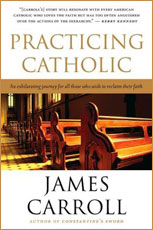A memoir recommended for those who feel a sense of sadness and disappointment in the modern day Catholic Church but who also want to see its positive side including its social justice, liturgical beauty,
and global vision.
Today there are 70 million self-identified Catholics in the United States, about a quarter of the nation's population; they are registered in 20,000 parishes. They put about a billion dollars a year in collection baskets. In the past 30 years, the number of native-born U.S. Catholics has declined but they have been replaced by newly arrived immigrants, mainly from Latin America.
James Carroll is a writer of novels and histories, a Boston Globe columnist, a former Paulist priest, and a loyal Catholic born in Chicago in 1943. Early in this muscular spiritual memoir, he acknowledges that "Catholic history is nothing but a saga of glory and tragedy, corruption and reform, false starts and new beginnings."
On the positive side, Carroll salutes a tradition centered on social justice, accommodation of immigrants, the work of peace, sacramental respect for creation, liturgical beauty, and global vision.
On the negative side, the author laments the radical conservatism of the present Pope, the Church's shabby treatment of women, the infamies of the Inquisition, the clergy sex abuse scandals, anti-Semitism, and spiritual imperialism.
"I was born a white American male near the middle of the twentieth century, which puts me in history's charmed circle," writes Carroll. But he also remembers the stench of Chicago's stock-yards, the self-hatred of his parents as Irish-Americans, fish on Friday and Mass on Sunday, the militant adherence to "No salvation outside the Church," and the belief in the infallibility of the Pope. In a chapter on coming-of-age, Carroll pays tribute to Cardinal Cushing, a liberal and down-to-earth Catholic leader. In the next chapter, he ponders the changes brought by Pope John XXIII who saw the Church as a dark and musty house in need of fresh air. Vatican II did bring reform but these changes were gradually undermined by a succession of more conservative Popes. Carroll also clarifies the Church's attempts to exert control over the lives of believers through an emphasis on birth control, imposed celibacy, and "clergy-sponsored discrimination by gender" as a means of stemming the tide of the women's liberation movement.
Along the way, Carroll pays tribute to the Trappist monk Thomas Merton, the Yale University Protestant chaplain William Sloane Coffin, Jr., and the Swiss Catholic theologian Hans Kung, who all made invaluable contributions to his personal faith and belief in change for a better world. The author saves his righteous indignation for the two standard bearers for the rise of what he calls "a new Catholic fundamentalism" — John Paul II who was determined "to restore the medieval European Catholicism into which he was born" and his successor Pope Benedict XVI who before assuming office was a harsh critic of the liberalizing tendencies of Vatican II, a chief sponsor of denial during the sex-abuse crisis, a rigorous crusader against liberation theologians (he excommunicated many of them), and a defender of the Catholic prohibition of women as priests as infallible teaching. Hats off to Carroll for the boldness with which he exposes the harsh zealotry of Pope Benedict XVI and the dangers it poses to interreligious dialogue.
In a chapter titled "A Writer's Faith," the author acknowledges that God is greater than any language used about God and far surpasses all religions with the bounties of both mystery and grace. As forceful as this writer is in his language about the Church, he yields to mystery in his descriptions of the Divine.
